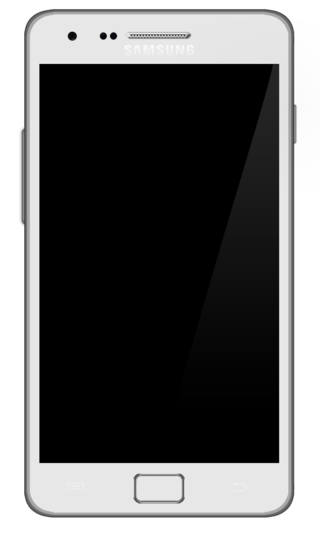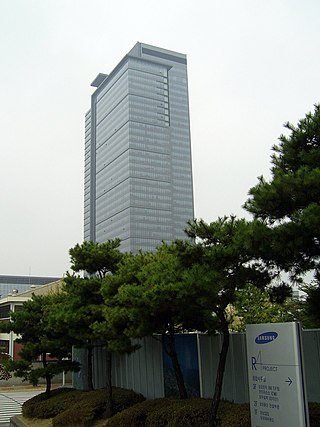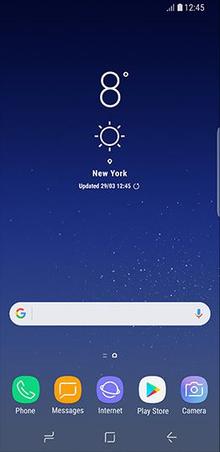
The N-Gage is a mobile device combining features of a cellular phone and a handheld game system developed by Nokia, released on 7 October 2003. Officially nicknamed as the game deck, the N-Gage's phone works on the GSM cellular network, and software-wise runs on the Series 60 platform on top of Symbian OS v6.1.
The Samsung SPH-i500 was a Palm OS-based smartphone manufactured by Samsung Electronics. It was previewed at CommunicAsia 2002 in June and launched later that year. It was later discontinued in August 2005. It was marketed in the United States for use on Sprint's mobile phone network.

The Samsung SPH-N270 or Matrix phone is a bar style mobile phone released in 2003, made to resemble the phone used in The Matrix Reloaded. The design crew of the Matrix worked closely with Samsung to develop a phone whose features and release date would coincide with the movie. The SPH-N270 was not intended as a mainstream phone for everyday use. Instead, it was marketed solely to fans of the series as a piece of rare, high quality merchandise.
The Samsung SPH-A640 is a tri-mode dual band cellular telephone developed for PCS carriers like Sprint Nextel in the United States and Virgin Mobile in Canada. It was released in mid to late 2006 in most areas in the United States and other countries such as Canada.

N-Gage, also referred to as N-Gage 2.0, was a mobile gaming digital distribution platform from Nokia that was available for several Nokia smartphones running on S60 (Symbian). The successor to the original N-Gage gaming device and launched as part of their Ovi initiative in 2007, it aimed to offer AAA games for trial and purchase into a single application with full compatibility to all devices, along with online multiplayer and social features using N-Gage Arena via in-house servers. Games on the platform were natively coded or ported using C++ although N-Gage used APIs from its own SDK separate from Symbian's. Testing began in Finland in February 2007, but the service faced numerous delays before the service finally rolled out on April 3, 2008 with five launch titles, initially for Nokia N81, N82 and N95 owners.

Samsung Galaxy is a series of computing and Android mobile computing devices that are designed, manufactured and marketed by Samsung Electronics since 29 June 2009. The product line includes the Samsung Galaxy S series of high-end phones, Galaxy Z series of high-end foldables, Galaxy A series, Galaxy F series and Galaxy M series of mid-range phones, the Galaxy Book of laptops, the Samsung Galaxy Tab series, the Samsung Galaxy Watch, the Galaxy Buds series and the Galaxy Fit, and the now historical Galaxy Note series of pioneering phablets.

The Samsung Moment, known as SPH-M900, is a smartphone manufactured by Samsung that uses the open source Android operating system.

The Samsung Galaxy S is a touchscreen-enabled, slate-format Android smartphone developed and marketed by Samsung Electronics; it is the first smartphone of the Samsung Galaxy S series. It is the first device of the third Android smartphone series produced by Samsung. It was announced to the press in March 2010 and released for sale in June 2010. After the release of Android 2.2 "Froyo" for the Galaxy S, Samsung released a successor to the device called S scLCD or SL and ceased production of the original I9000 model due to shortage of Super AMOLED displays.

Gorilla Glass, developed and manufactured by Corning, is a brand of chemically strengthened glass now in its ninth generation. Designed to be thin, light, and damage-resistant, its surface strength and crack-resistance are achieved through immersion in a hot potassium-salt ion-exchange bath.

The Samsung Galaxy S II is a touchscreen-enabled, slate-format Android smartphone developed and marketed by Samsung Electronics, as the second smartphone of the Samsung Galaxy S series. It has additional software features, expanded hardware, and a redesigned physique compared to its predecessor, the Samsung Galaxy S. The S II was launched with Android 2.3.3/2.3.4 "Gingerbread", with updates to Android 4.1.2 "Jelly Bean".

The Samsung Galaxy Note II is an Android phablet smartphone. Unveiled on August 29, 2012 and released in October 2012, the Galaxy Note II is a successor to the original Galaxy Note, incorporating improved stylus functionality, a larger 5.5-inch (140 mm) screen, and an updated hardware and casing design based on that of the Galaxy S III.

Imageon was a series of media coprocessors and mobile chipsets produced by ATI in 2002–2008, providing graphics acceleration and other multimedia features for handheld devices such as mobile phones and Personal Digital Assistants (PDAs). AMD later sold the Imageon mobile handheld graphics division to Qualcomm in 2009, where it was used exclusively inside their Snapdragon SoC processors under the Adreno brand name.
Samsung SCH-B450 is a gaming phone released by Samsung in July 2006 in South Korea. It features a 2.2-inch TFT-LCD, a 2.0-megapixel camera, a DMB receiver for mobile television and 3D-gaming capabilities. It was primarily designed for video games playing experience.
Samsung SPH-G1000 is a gaming phone introduced by Samsung in March 2005 at the CTIA show. It features a 2.2-inch TFT-LCD display, a 1.3-megapixel camera and a 3D acceleration chip for 3D-gaming capabilities. It was primarily designed for video games playing. It was released in South Korea in April 2005.
GPANG was a 3D mobile game service introduced in 2004 by the Korean provider KTF. This service allowed subscribers to access a downloadable game portal and play advanced 3D mobile games, including MMOs. KTF's GPANG competed with SK Telecom's own 3D mobile game service called GXG. On June 1 2009, GPANG ceased to exist.

Samsung Electronics Co., Ltd. is a South Korean multinational major appliance and consumer electronics corporation founded on 13 January 1969 and headquartered in Yeongtong District, Suwon, South Korea. It is currently the pinnacle of the Samsung chaebol, accounting for 70% of the group's revenue in 2012, and has played a key role in the group's corporate governance due to cross ownership. It is majority-owned by foreign investors.
The Samsung Galaxy Mega 2 is an Android smartphone/tablet computer hybrid manufactured by Samsung, the successor to the Samsung Galaxy Mega. It was released in October 2014.

Samsung Experience was the name of the software overlay by Samsung for its Galaxy devices running Android 7.x “Nougat” and Android 8.x “Oreo”. It was introduced in late 2016 on a beta build based on Android 7.0 “Nougat” for the Galaxy S7, succeeding TouchWiz. It has been succeeded in 2018 by One UI based on Android 9 “Pie” and later versions.

The Samsung Galaxy A70 and A70s are a series of Android phablets manufactured by Samsung Electronics as part of its fifth-generation Galaxy A series lineup. The phones feature Android 9 (Pie) with Samsung's proprietary One UI skin, 128 GB of internal storage, and a 4500 mAh battery. The A70 was unveiled in South Korea on April 19, 2019.

The Samsung Galaxy Note 20 and Galaxy Note 20 Ultra are a series of high-end Android-based phablets developed, produced, and marketed by Samsung Electronics as part of their Samsung Galaxy Note series, succeeding the Samsung Galaxy Note 10 series. The phablets were announced on 5 August 2020 alongside the Samsung Galaxy Z Fold 2, Galaxy Watch 3, Galaxy Buds Live and Samsung Galaxy Tab S7 during Samsung's Unpacked Event. It was the final model in the Galaxy Note series, with Samsung beginning to integrate the functionality from the Note series into its S series "Ultra" models, starting with the Galaxy S22 Ultra released in February 2022.













